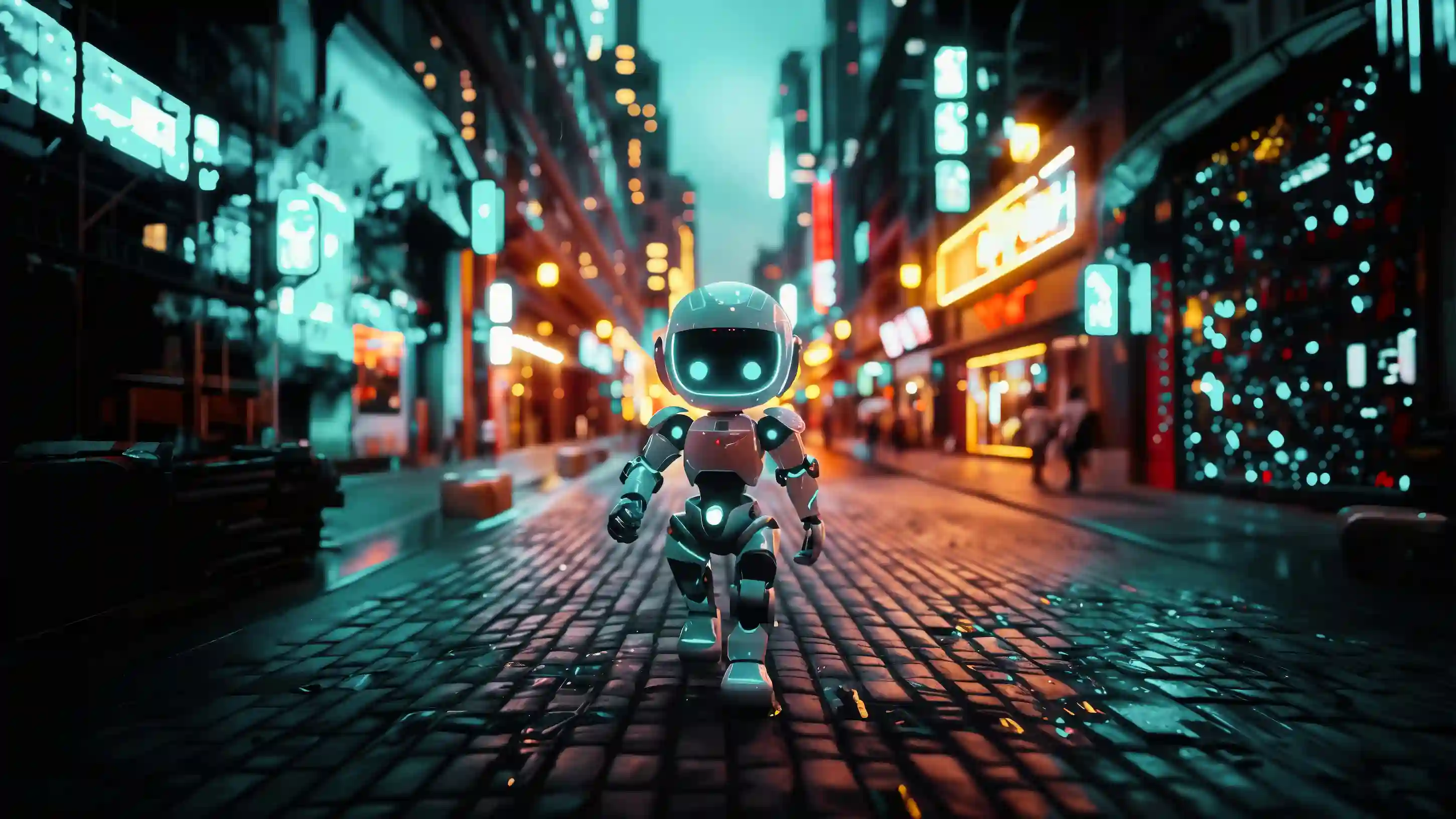If someone had told you a few years ago that AI could write novels, paint like Van Gogh, or create hyper-realistic videos out of thin air, you probably would have laughed and asked what sci-fi movie they were watching.
But fast forward to 2025, and not only is Generative-AI doing all that, it is doing it so well that even experts sometimes struggle to tell what is real and what is machine-made. What started as a niche tech experiment has turned into a full-blown creative revolution.
However, with new AI models appearing left and right, it is easy to feel overwhelmed. Some are helping businesses automate content, while others are pushing the limits of what machines can create.
The real question is, which ones actually matter? Which models are leading the way, shaping industries, and making us rethink everything we thought we knew about intelligence and originality?
That is exactly what we are about to explore.
What is Generative AI?
AI has been great at a lot of things, but creativity? That always seemed like something uniquely human, until now. Thanks to breakthroughs in deep learning, natural language processing (NLP), and neural networks, AI can now generate content that looks, sounds, and even feels like it was made by a person.
Generative AI is a type of artificial intelligence that creates entirely new content, from text and images to music, videos, and even computer code. Unlike traditional AI, which is designed to recognize patterns and make decisions based on existing data, generative AI goes a step further. It learns from massive datasets, understands patterns, and then produces original outputs that mimic human creativity.
The results are everywhere. AI-generated chatbots are holding conversations that feel eerily natural. Image-generation models are creating stunning artwork from just a few words. AI-powered music tools are composing symphonies, while code-writing AI is helping developers build software faster than ever.
What started as an experimental technology is now reshaping industries. Businesses are using it to automate content creation, creatives are using it to spark new ideas, and tech companies are racing to push its capabilities even further.
How Does Generative AI Work?
If you’ve ever watched a magician pull a rabbit out of a hat, you might have wondered, How did they do that? Generative AI can feel the same way.
It takes a simple prompt, whether it’s a sentence, an image description, or a few lines of code, and turns it into something completely new. But unlike magic, there’s no illusion here. It all comes down to data, patterns, and a whole lot of computing power.
Let’s break it down step by step.
Step 1: Learning from Massive Amounts of Data
Every generative AI model starts with a learning phase. It learns from massive datasets that contain examples of whatever it is trying to generate.
- A language model (like GPT) studies billions of words from books, websites, and articles.
- An image model (like Stable Diffusion) looks at millions of labeled pictures to understand shapes, colors, and textures.
- A music model listens to thousands of songs to learn melodies, harmonies, and rhythms.
- A coding model analyzes open-source projects to understand different programming languages.
Before the AI can start generating anything, this data is cleaned and preprocessed to remove errors and inconsistencies, ensuring the model learns from high-quality information.
Step 2: Identifying Patterns and Structures
Once the AI has enough data, it starts looking for patterns. It doesn’t "understand" the data the way humans do, but it recognizes statistical relationships.
For example, a text model learns that certain words often appear together in a sentence, like "peanut butter" and "jelly." An image model understands that a cat usually has two ears, whiskers, and fur. A music model figures out that upbeat pop songs often follow a particular chord progression.
This pattern recognition forms the foundation for how AI predicts and generates new content.
Step 3: Training Neural Networks to Generate Content
After identifying patterns, the AI undergoes training using neural networks, which are inspired by the way the human brain processes information.
Different types of generative AI models use different architectures:
- Text-based models use transformers (like GPT-4 and Claude) that analyze the relationships between words and generate logical sentences.
- Image models use diffusion models that start with random noise and refine it into a recognizable image.
- Music and speech models use recurrent neural networks (RNNs) or convolutional neural networks (CNNs) to replicate sound patterns.
- Code-generation models analyze syntax structures to write functional programs in different programming languages.
The AI practices generating content and refines its approach by comparing its results to real-world examples.
Step 4: Generating Content Based on Prompts
Once trained, the AI is ready to create. It works by predicting the most likely next step based on a given input.
- If you give a text model the prompt, "Once upon a time," it predicts what words are most likely to come next based on what it has learned from past stories.
- If you describe an image, "a futuristic city at sunset," an AI like Midjourney, Sora or Stable Diffusion assembles an image pixel by pixel, following the patterns of thousands of other sunset and cityscape images it has seen.
- If you ask an AI to generate a melody in the style of Beethoven, it arranges musical notes in a way that reflects Beethoven’s signature style.
Note: AI doesn’t copy exact pieces from its training data. Instead, it combines patterns in unique ways, creating something new each time.
Step 5: Refining and Improving the Output
Generative AI isn’t perfect. Sometimes, it produces incorrect or nonsensical results. To improve its accuracy, many AI models use refinement techniques, such as:
Reinforcement Learning from Human Feedback (RLHF): AI gets better over time by receiving feedback on whether its outputs are correct, coherent, or useful.
Filtering and fine-tuning: Developers adjust the AI’s training data and tweak algorithms to reduce bias, errors, or unintended outputs.
Adaptive learning: Some models continuously update themselves based on new information, keeping their knowledge fresh and relevant.
This continuous improvement process helps AI generate more reliable and human-like content over time.
Step 6: Real-World Applications and User Interaction
Once the AI is fully trained and optimized, it is deployed for real-world use. People interact with it through apps, websites, and software tools. Some common applications include:
- Chatbots and virtual assistants (like ChatGPT and Google Gemini) for customer support and conversation.
- AI image generators (like Midjourney and DALL·E) for design and creative projects.
- Code-writing AI (like GitHub Copilot) to help developers write and debug code faster.
- Music composition AI that generates original songs and soundtracks.
With every interaction, the AI continues to learn, refine its responses, and become more effective at generating content that feels natural and human-like.
Most Used Generative AI Models
Now that we know what generative AI is and how it works, let’s talk about the real game-changers, the models that are actually being used every day.
Some generate text so naturally that you might mistake them for a human. Others create stunning images from just a few words. Some even write code, compose music, or help businesses automate tasks that once took hours. These AI powerhouses are shaping industries, redefining creativity, and proving that machines can do a lot more than just crunch numbers.
Here are seven of the most widely used generative AI models in 2025.
1. GPT-4
GPT-4 Language Model is one of the most powerful and widely used generative AI models. It powers ChatGPT and is a go-to tool for writing, coding, research, and customer support.
Built on an advanced transformer-based neural network, GPT-4 processes massive amounts of text data to generate natural, context-aware responses. It uses reinforcement learning from human feedback (RLHF) to improve accuracy and relevance, along with self-supervised learning and fine-tuning techniques to enhance performance.
Unlike older models, GPT-4 can also access the internet in certain versions, allowing it to retrieve real-time information.
Here’s what GPT-4 can do:
- Text Generation – Writes articles, essays, scripts, and marketing copy.
- Conversational AI – Powers chatbots and virtual assistants with human-like responses.
- Programming Assistance – Helps debug, generate, and explain code.
- Research and Learning – Summarizes complex topics and provides insights.
- Creative Ideation – Assists with brainstorming, storytelling, and content planning.
With multilingual support, long-form memory, and human-like fluency, GPT-4 is redefining how we interact with AI.
2. Google Gemini
Google Gemini, developed by Google DeepMind, is a multimodal AI model that can process and generate text, images, audio, video, and code within a single framework. While most AI models specialize in one area, Gemini’s versatility makes it one of the most advanced generative AI systems today.
Here’s why it’s one of the most used generative AI models:
- Multimodal AI – Handles text, images, audio, video, and code in one model.
- Advanced Reasoning – Excels in logic, science, and technical problem-solving.
- Google Integration – Enhances Search, Docs, Sheets, and YouTube.
- Real-Time Knowledge – Provides live internet access in supported versions.
- Developer-Friendly – Supports multiple coding languages for generation and debugging.
With its unmatched versatility, Gemini is redefining how AI interacts with the world.
3. Claude 3
Claude 3, developed by Anthropic, is a conversational AI model built for long, context-aware discussions with a strong focus on safety and reliability. It is designed using AI alignment principles to ensure responses are ethical, unbiased, and transparent.
With extended memory capabilities, Claude AI Chatbot retains context over long conversations, making it ideal for research, legal analysis, and business discussions. It also excels at nuanced reasoning, handling complex topics with accuracy while minimizing misinformation.
Claude 3 mainly stands out because:
- Longer Context Retention – Maintains coherence over extended conversations.
- Ethical and Aligned AI – Reduces misinformation and biased responses.
- Strong Reasoning Skills – Ideal for legal, business, and research applications.
- Natural Conversational Flow – Generates responses that feel more human-like.
- Privacy-Focused – Designed with stronger safeguards for user data security.
Claude 3 is a top choice for those who need a reliable, intelligent, and context-aware AI assistant for complex discussions and critical decision-making.
4. LLaMA 3
An open-source generative AI model, LLaMA 3 is designed for text generation, research, and AI development. While GPT-4 or Google Gemini are closed-source and controlled by companies, LLaMA 3 is completely free and customizable, giving developers full control over how they use it. And because it’s open-source, anyone can fine-tune it for specific needs, whether it's powering a chatbot, assisting with research, or generating content. It’s also efficient and scalable, meaning it can run on different hardware setups without requiring massive computing power.
But what exactly makes LLaMA 3 stand out?
- Fully Open-Source – No restrictions, free for anyone to use and modify.
- Highly Customizable – Can be fine-tuned for different applications.
- Efficient and Scalable – Runs smoothly on various hardware setups.
- Strong Language Generation – Produces coherent, context-aware text.
- Great for Research – A top choice for universities and AI developers.
LLaMA 3 is shaping the future of open AI, giving users more flexibility than closed alternatives.
5. Midjourney Image Generator
Ever wanted to create jaw-dropping artwork without lifting a paintbrush or mastering design software? That’s exactly what Midjourney does. This AI-powered image generator turns simple text prompts into stunning, high-quality visuals in seconds.
Whether you want realistic portraits, futuristic landscapes, fantasy art, or something completely abstract, Midjourney delivers. It runs entirely on Discord, making it super easy to generate images, tweak results, and share creations with a community of artists and AI enthusiasts.
Here’s why people are loving Midjourney:
- No Design Skills Needed – Just describe what you want, and AI makes it happen.
- Insanely Realistic & Creative – From hyper-realistic faces to dreamy fantasy scenes.
- Fast & Effortless – Get high-quality images in seconds.
- Community-Driven – Hosted on Discord, where users share and refine their work.
- Customizable & Versatile – Supports fine-tuning, upscaling, and artistic styles.
In short, Midjourney is redefining digital creativity, making AI art more accessible and exciting than ever.
6. Stable Diffusion XL
Stable Diffusion is the go-to AI model for anyone who wants full control over AI-generated images. Unlike cloud-based platforms that limit customization, this open-source model lets users generate high-quality visuals on their own computers.
What makes it truly stand out is its local run capability. Instead of relying on online services, users can download and operate the model on their own hardware, meaning no internet dependency, no paywalls, and no hidden restrictions. It’s also highly modifiable, allowing artists and developers to fine-tune settings, train custom models, and push the boundaries of AI-generated art in ways closed platforms simply don’t allow.
Here’s what makes Stable Diffusion unique:
- Completely Open-Source – No restrictions, free for anyone to use and modify.
- Runs Locally – Generate images on your own computer without cloud-based limitations.
- Highly Customizable – Adjust settings, fine-tune styles, and train custom models.
- Realistic & Artistic Outputs – Supports a wide range of visual styles.
- Developer-Friendly – Ideal for AI researchers, digital artists, and creative professionals.
Stable Diffusion is perfect for those who want full creative control over AI-generated art, making it a favorite among independent creators and developers.
7. GitHub Copilot
Coding often involves repetitive tasks and constant troubleshooting, but GitHub Copilot changes that. Acting as an AI-powered coding assistant, it auto-completes lines, suggests entire functions, and even helps debug errors in real time, making development smoother and more efficient.
What sets Copilot apart is its ability to understand your code in context. It recognizes patterns, adapts to different programming languages and frameworks, and provides relevant, intelligent suggestions to streamline your workflow. Whether you're working in Python, JavaScript, or C++, Copilot helps you write cleaner, faster, and more efficient code with less effort.
Here’s what sets it apart:
- Smart Code Suggestions – Predicts and auto-completes code in real time.
- Multi-Language Support – Works with Python, JavaScript, Go, C++, and more.
- Context-Aware – Understands the structure of your code for relevant recommendations.
- Debugging Assistance – Identifies errors and suggests fixes.
- Seamless IDE Integration – Works inside VS Code, JetBrains, and other coding environments.
GitHub Copilot is changing the way developers write code, making software development faster, more intuitive, and less repetitive.
The Future of Generative AI Models
Generative AI is advancing rapidly, with new models emerging regularly, each more powerful and capable than the last. As competition intensifies, companies are developing AI that is faster, more efficient, and better at understanding complex tasks, making the future of AI more dynamic than ever.
Among the newest models is Grok, developed by Elon Musk’s company xAI. Designed to compete with mainstream AI assistants, Grok offers real-time internet access, deep contextual understanding, and an interactive, human-like approach to conversation.
Another rising AI model is DeepSeek, which focuses on multimodal capabilities, improving how AI processes and generates text, images, and code. These models signal a shift toward more adaptable, real-time AI interactions that feel increasingly intuitive and useful.
Beyond better AI models, quantum computing could be the next major leap. Unlike traditional computing, which processes data in a linear fashion, quantum AI could solve complex problems exponentially faster. This would enable AI to handle tasks like drug discovery, financial modeling, and climate simulations with unprecedented speed and accuracy.
With new models constantly emerging and quantum computing on the horizon, the future of generative AI is set to be faster, more competitive, and more transformative than ever before.
Let’s Get Started!
Generative AI is reshaping industries, redefining creativity, and automating tasks in ways we never imagined. And with AI models becoming smarter, faster, and more accessible, the real question isn’t whether to use AI, but how to use it effectively.
That’s where things get tricky. With so many AI models and solutions available, figuring out the right approach for your business can feel overwhelming. But you don’t have to navigate this transformation alone. Eminence specializes in Generative AI Development solutions that help businesses seamlessly integrate cutting-edge AI models into their workflows.
The future of AI is already here, and those who adapt will lead the way. The real question is: Are you ready to take that step?
Let’s build, innovate, and grow, together. Reach out to Eminence today and start unlocking the power of AI for your business!
















